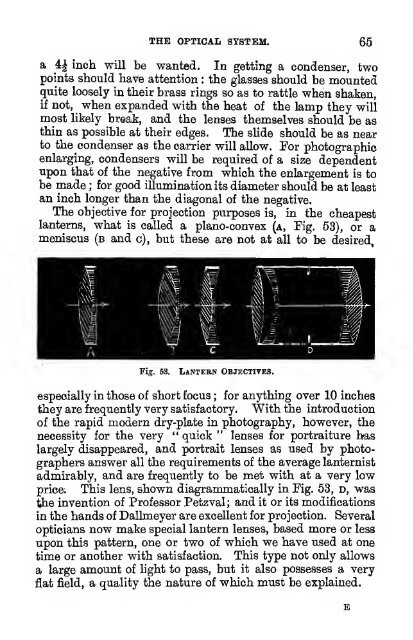Modern magic lanterns; a guide to the ... - Yesterday Image
Modern magic lanterns; a guide to the ... - Yesterday Image
Modern magic lanterns; a guide to the ... - Yesterday Image
- No tags were found...
Create successful ePaper yourself
Turn your PDF publications into a flip-book with our unique Google optimized e-Paper software.
THE OPTICAL SYSTEM. 65a 4| inch will be wanted. In getting a condenser, twopoints should have attention : <strong>the</strong> glasses should be mountedquite loosely in <strong>the</strong>ir brass rings so as <strong>to</strong> rattle when shaken,if not, when expanded with <strong>the</strong> heat of <strong>the</strong> lamp <strong>the</strong>y willmost likely break, and <strong>the</strong> lenses <strong>the</strong>mselves should be asthin as possible at <strong>the</strong>ir edges. The slide should be as near<strong>to</strong> <strong>the</strong> condenser as <strong>the</strong> carrier will allow. For pho<strong>to</strong>graphicenlarging, condensers will be required of a size dependentupon that of <strong>the</strong> negative from which <strong>the</strong> enlargement is <strong>to</strong>be made ; for good illumination its diameter should be at leastan inch longer than <strong>the</strong> diagonal of <strong>the</strong> negative.The objective for projection purposes is, in <strong>the</strong> cheapest<strong>lanterns</strong>, what is called a plano-convex (a, Fig. 53), or ameniscus (b and c), but <strong>the</strong>se are not at all <strong>to</strong> be desired.Fig. 53. Lantern Objectives.especially in those of short focus ; for anything over 10 inches<strong>the</strong>y are frequently very satisfac<strong>to</strong>ry. With <strong>the</strong> introductionof <strong>the</strong> rapid modern dry-plate in pho<strong>to</strong>graphy, however, <strong>the</strong>necessity for <strong>the</strong> very " quick " lenses for portraiture haslargely disappeared, and portrait lenses as used by pho<strong>to</strong>graphersanswer all <strong>the</strong> requirements of <strong>the</strong> average lantemistadmirably, and are frequently <strong>to</strong> be met with at a very lowprice. This lens, shown diagrammatically in Fig. 53, d, wasyie invention of Professor Petzval; and it or its modificationsin <strong>the</strong> hands of Dalhneyer are excellent for projection. Severalopticians now make special lantern lenses, based more or lessupon this pattern, one or two of which we have used at onetime or ano<strong>the</strong>r with satisfaction. This type not only allowsa large amount of light <strong>to</strong> pass, but it also possesses a veryflat field, a quality <strong>the</strong> nature of which must be explained.





